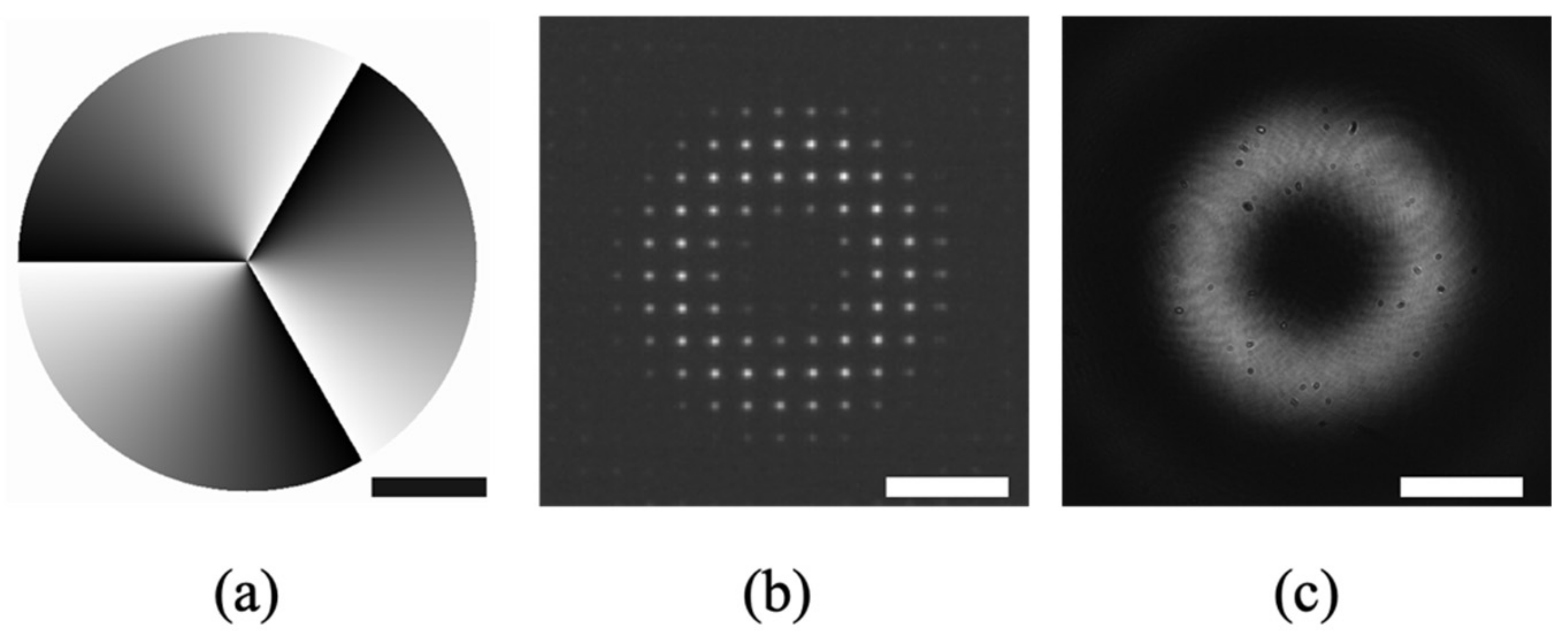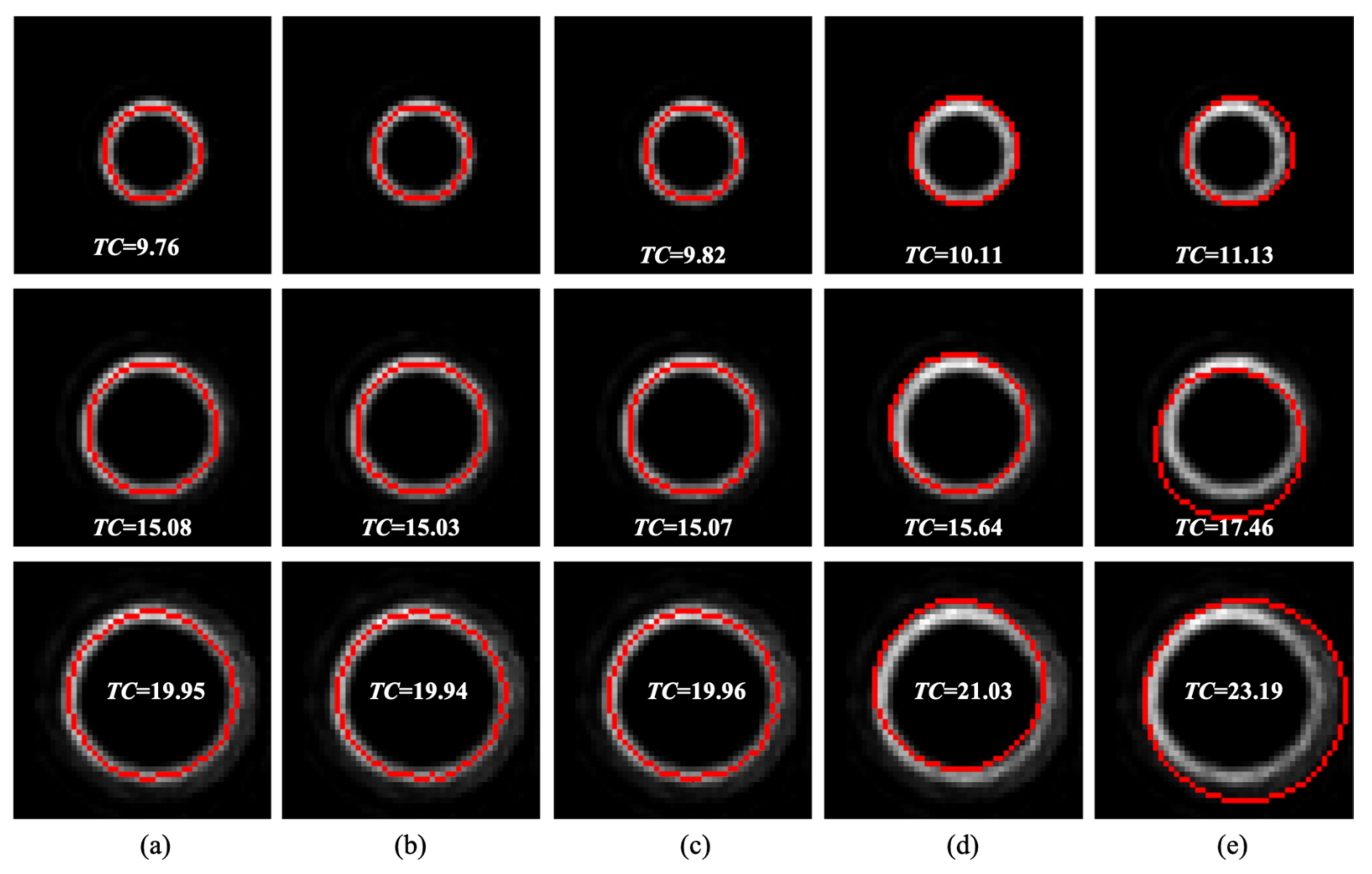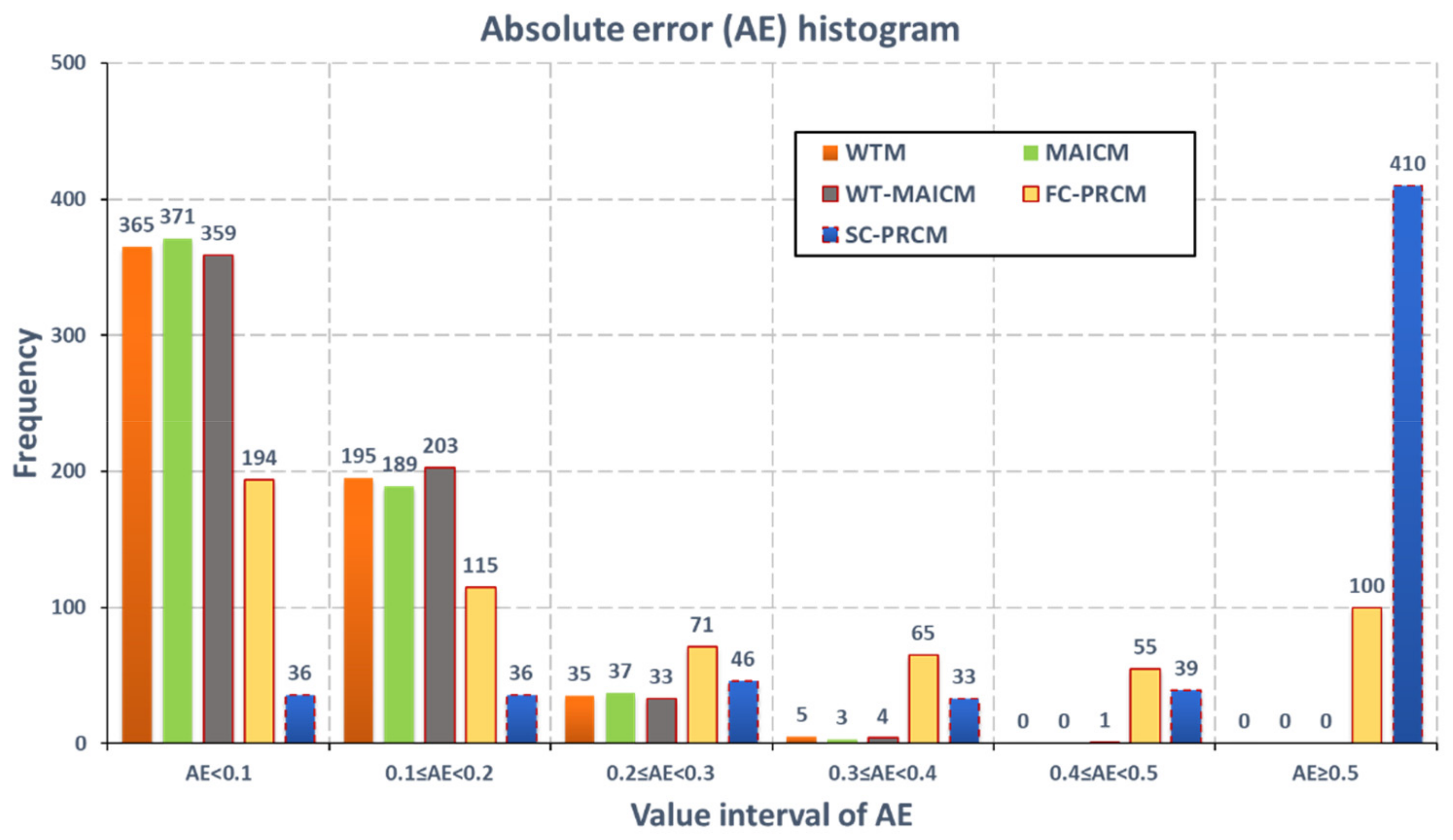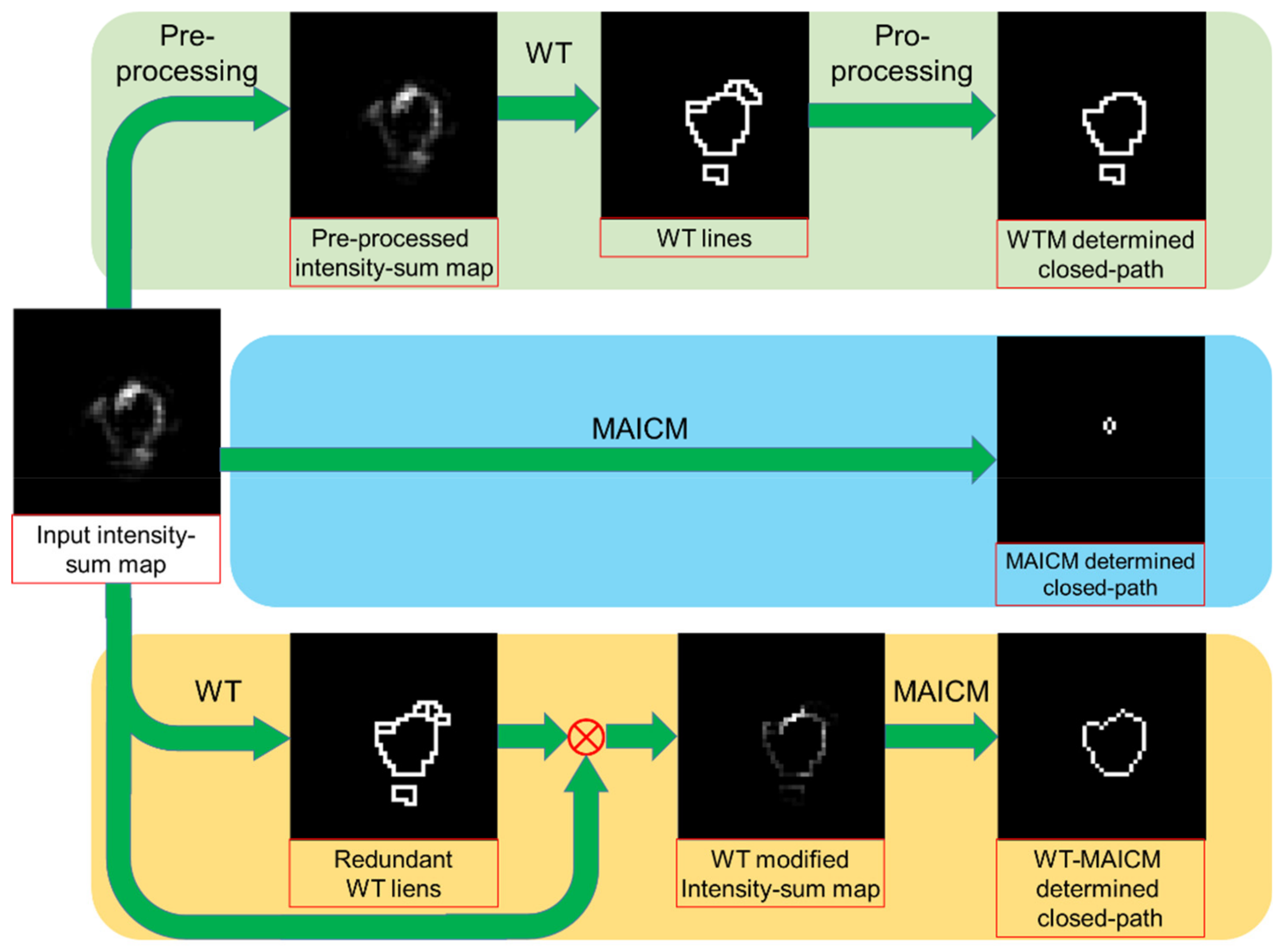Topological Charge Detection Using Generalized Contour-Sum Method from Distorted Donut-Shaped Optical Vortex Beams: Experimental Comparison of Closed Path Determination Methods
Abstract
:Featured Application
Abstract
1. Introduction
2. Generalized Contour-Sum Method
3. Methods for Closed Path Determination
3.1. Watershed Transformation Method
3.2. Maximum Average-Intensity Circle Extraction
3.3. Watershed Transformed Maximum Average-Intensity Circle Extraction
3.4. Perfectly Round Circle Assignation
- The method determining the center position of the generated perfectly round circles by the centroid of intensity sum map is not optimal, because the nonuniformity along the azimuthal direction in the intensity sum distribution significantly affects the centroid calculation.
- The center position as well as the radius are all forced to be integers.
- The generated circles restricted to perfectly round shapes will unavoidably go through the low-intensity region, which means that invalid phase slope data will be obtained.
4. Experimental Setup
5. Results and Discussion
5.1. Performance Comparison Based on Aberration-Free OV Beams
5.2. Performance Comparison Based on Distorted OV Beams
6. Conclusions
Author Contributions
Funding
Acknowledgments
Conflicts of Interest
References
- Bozinovic, N.; Yue, Y.; Ren, Y.; Tur, M.; Kristensen, P.; Huang, H.; Willner, A.E.; Ramachandran, S. Terabit-scale orbital angular momentum mode division multiplexing in fibers. Science 2013, 340, 1545–1548. [Google Scholar] [CrossRef] [PubMed]
- Zhang, D.; Feng, X.; Huang, Y. Encoding and decoding of orbital angular momentum for wireless optical interconnects on chip. Opt. Express 2012, 20, 26986–26995. [Google Scholar] [CrossRef] [PubMed]
- Wang, J.; Yang, J.Y.; Fazal, I.M.; Ahmed, N.; Yan, Y.; Huang, H.; Ren, Y.; Yue, Y.; Dolinar, S.; Tur, M.; et al. Terabit free-space data transmission employing orbital angular momentum multiplexing. Nat. Photonics 2012, 6, 488. [Google Scholar] [CrossRef]
- Li, S.; Wang, J. Experimental demonstration of optical interconnects exploiting orbital angular momentum array. Opt. Express 2017, 25, 21537–21547. [Google Scholar] [CrossRef] [PubMed]
- Chu, S. Laser Manipulation of Atoms and Particles. Science 1991, 253, 861–866. [Google Scholar] [CrossRef] [PubMed]
- Otsu, T.; Ando, T.; Takiguchi, Y.; Ohtake, Y.; Toyoda, H.; Itoh, H. Direct evidence for three-dimensional off-axis trapping with single Laguerre-Gaussian beam. Sci. Rep. 2014, 4, 4579. [Google Scholar] [CrossRef] [PubMed] [Green Version]
- Liphardt, J.; Dumont, S.; Smith, S.B.; Tinoco, I.; Bustamante, C. Equilibrium information from nonequilibrium measurements in an experimental test of Jarzynski’s equality. Science 2002, 296, 1832–1835. [Google Scholar] [CrossRef] [PubMed]
- Sato, S.; Fujimoto, I.; Kurihara, T.; Ando, S. Remote six-axis deformation sensing with optical vortex beam. In Proceedings of the Free-Space Laser Communication Technologies XX, San Jose, CA, USA, 19–24 January 2008. [Google Scholar]
- Wang, W.; Yokozeki, T.; Ishijima, R.; Takeda, M.; Hanson, S.G. Optical vortex metrology based on the core structures of phase singularities in Laguerre-Gauss transform of a speckle pattern. Opt. Express 2006, 14, 10195–10206. [Google Scholar] [CrossRef] [PubMed]
- Fujimoto, I.; Sato, S.; Kim, M.Y.; Ando, S. Optical vortex beams for optical displacement measurements in a surveying field. Meas. Sci. Technol. 2011, 22, 105301. [Google Scholar] [CrossRef]
- Nye, J.F.; Berry, M.V. Dislocations in wave trains. Proc. R. Soc. Lond. A Math. Phys. Sci. 1974, 336, 165–190. [Google Scholar] [CrossRef]
- Fried, D.L.; Vaughn, J.L. Branch cuts in the phase function. Appl. Opt. 1992, 31, 2865–2882. [Google Scholar] [CrossRef] [PubMed]
- Rockstuhl, C.; Ivanovskyy, A.A.; Soskin, M.S.; Salt, M.G.; Herzig, H.P.; Dändliker, R. High-resolution measurement of phase singularities produced by compute-generated holograms. Opt. Commun. 2004, 242, 163–169. [Google Scholar] [CrossRef]
- Chen, R.; Zhang, X.; Zhou, Y.; Ming, H.; Wang, A.; Zhan, Q. Detecting the topological charge of optical vortex beams using a sectorial screen. Appl. Opt. 2017, 56, 4868–4872. [Google Scholar] [CrossRef] [PubMed]
- Hickmann, J.M.; Fonseca, E.J.; Soares, W.C.; Chávez-Cerda, S. Unveiling a truncated optical lattice associated with a triangular aperture using light’s orbital angular momentum. Phys. Rev. Lett. 2010, 105, 053904. [Google Scholar] [CrossRef] [PubMed]
- Prabhakar, S.; Kumar, A.; Banerji, J.; Singh, R.P. Revealing the order of a vortex through its intensity record. Opt. Lett. 2011, 36, 4398–4400. [Google Scholar] [CrossRef]
- Schulze, C.; Naidoo, D.; Flamm, D.; Schmidt, O.A.; Forbes, A.; Duparré, M. Wavefront reconstruction by modal decomposition. Opt. Express 2012, 20, 19714–19725. [Google Scholar] [CrossRef] [Green Version]
- Li, S.; Wang, J. Simultaneous demultiplexing and steering of multiple orbital angular momentum modes. Sci. Rep. 2015, 5, 15406. [Google Scholar] [CrossRef] [Green Version]
- Platt, B.C.; Shack, R. History and principles of Shack-Hartmann wavefront sensing. J. Refract. Surg. 2001, 17, S573–S577. [Google Scholar] [CrossRef]
- Chen, M.; Roux, F.S.; Olivier, J.C. Detection of phase singularities with a Shack-Hartmann wavefront sensor. J. Opt. Soc. Am. A 2007, 24, 1994–2002. [Google Scholar] [CrossRef] [Green Version]
- Le Bigot, E.O.; Wild, W.J. Theory of branch-point detection and its implementation. J. Opt. Soc. Am. A 1999, 16, 1724–1729. [Google Scholar] [CrossRef]
- Huang, H.; Luo, J.; Matsui, Y.; Toyoda, H.; Inoue, T. Eight-connected contour method for accurate position detection of optical vortices using Shack–Hartmann wavefront sensor. Opt. Eng. 2015, 54, 111302. [Google Scholar] [CrossRef]
- Luo, J.; Huang, H.; Matsui, Y.; Toyoda, H.; Inoue, T.; Bai, J. High-order optical vortex position detection using a Shack-Hartmann wavefront sensor. Opt. Express 2015, 23, 8706–8719. [Google Scholar] [CrossRef] [PubMed]
- Wang, D.; Huang, H.; Matsui, Y.; Tanaka, H.; Toyoda, H.; Inoue, T.; Liu, H. Aberration-resistible topological charge determination of annular-shaped optical vortex beams using Shack–Hartmann wavefront sensor. Opt. Express 2019, 27, 7803–7821. [Google Scholar] [CrossRef] [PubMed]
- Beucher, S.; Lantuejoul, C. Use of watersheds in contour detection. In Proceedings of the International Workshop Image Processing, Real-Time Edge and Motion Detection/ Estimation, CCETT/IRISA, Rennes, France, 17–21 September 1979. [Google Scholar]
- Meyer, F.; Beucher, S. Morphological segmentation. JVCIP 1990, 1, 21–46. [Google Scholar] [CrossRef]
- Meyer, F. Topographic distance and watershed lines. Signal. Process. 1994, 38, 113–125. [Google Scholar] [CrossRef]
- Vincent, L.; Soille, P. Watersheds in digital spaces: An efficient algorithm based on immersion simulations. IEEE Trans. Pattern Anal. Mach. Intell. 1991, 13, 583–598. [Google Scholar] [CrossRef]
- Osma-Ruiz, V.; Godino-Llorente, J.I.; Sa´enz-Lecho´n, N.; Go´mez-Vilda, P. An improved watershed algorithm based on efficient computation of shortest paths. Pattern Recognit. 2007, 40, 1078–1090. [Google Scholar] [CrossRef]
- Watershed Function in MathWorks. Available online: https://www.mathworks.com/help/images/ref/watershed.html?s_tid=srchtitle (accessed on 11 August 2019).
- Inoue, T.; Tanaka, H.; Fukuchi, N.; Takumi, M.; Matsumoto, N.; Hara, T.; Yoshida, N.; Igasaki, Y.; Kobayashi, Y. LCOS spatial light modulator controlled by 12-bit signals for optical phase-only modulator. Proc. SPIE 2007, 6487, 64870Y. [Google Scholar]
- Sugiyama, Y.; Takumi, M.; Toyoda, H.; Mukozaka, N.; Ihori, A.; Kurashina, T.; Nakamura, Y.; Tonbe, T.; Mizuno, S. A high-speed CMOS image sensor with profile data acquiring function. IEEE J. Solid State Circuits 2005, 40, 2816–2823. [Google Scholar] [CrossRef]
- Tyson, R.K. Principles of Adaptive Optics; Academic: Salt Lake City, UT, USA, 1991. [Google Scholar]
- Kolmogorov, A.N. A refinement of previous hypotheses concerning the local structure of turbulence in a viscous incompressible fluid at high Reynolds number. J. Fluid Mech. 1962, 13, 82–85. [Google Scholar] [CrossRef] [Green Version]
- Roddier, N.A. Atmospheric wavefront simulation using Zernike polynomials. Opt. Eng. 1990, 29, 1174–1180. [Google Scholar] [CrossRef]
- Fried, D.L. Statistics of a geometric representation of a wavefront distortion. J. Opt. Soc. Am. 1965, 55, 1427–1435. [Google Scholar] [CrossRef]










© 2019 by the authors. Licensee MDPI, Basel, Switzerland. This article is an open access article distributed under the terms and conditions of the Creative Commons Attribution (CC BY) license (http://creativecommons.org/licenses/by/4.0/).
Share and Cite
Wang, D.; Huang, H.; Toyoda, H.; Liu, H. Topological Charge Detection Using Generalized Contour-Sum Method from Distorted Donut-Shaped Optical Vortex Beams: Experimental Comparison of Closed Path Determination Methods. Appl. Sci. 2019, 9, 3956. https://doi.org/10.3390/app9193956
Wang D, Huang H, Toyoda H, Liu H. Topological Charge Detection Using Generalized Contour-Sum Method from Distorted Donut-Shaped Optical Vortex Beams: Experimental Comparison of Closed Path Determination Methods. Applied Sciences. 2019; 9(19):3956. https://doi.org/10.3390/app9193956
Chicago/Turabian StyleWang, Daiyin, Hongxin Huang, Haruyoshi Toyoda, and Huafeng Liu. 2019. "Topological Charge Detection Using Generalized Contour-Sum Method from Distorted Donut-Shaped Optical Vortex Beams: Experimental Comparison of Closed Path Determination Methods" Applied Sciences 9, no. 19: 3956. https://doi.org/10.3390/app9193956
APA StyleWang, D., Huang, H., Toyoda, H., & Liu, H. (2019). Topological Charge Detection Using Generalized Contour-Sum Method from Distorted Donut-Shaped Optical Vortex Beams: Experimental Comparison of Closed Path Determination Methods. Applied Sciences, 9(19), 3956. https://doi.org/10.3390/app9193956




